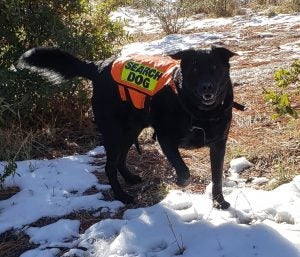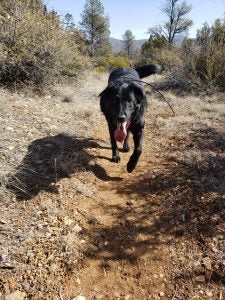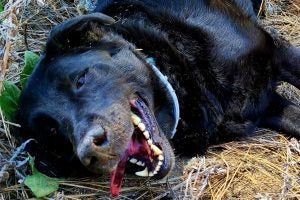
Rescue Dog Now Rescues Missing People
Left in a shelter as a puppy, Google was adopted by Heather Lum, who discovered Search & Rescue and thought he would be a good candidate. She was right. Google Search SAR-W CGCA TKN has worked for seven years locating lost people. “Google loves everything he does and is an example of how awesome shelter dogs can be,” Lum says.
Two hikers headed out for a day of foraging for ginseng. Hunting for the valuable herb meant going into remote wilderness in western Pennsylvania, and the two split up to better cover the area.
But when one returned to their meeting spot at the planned time, the other hiker did not. Soon law enforcement was summoned, and a missing person search organized.
It was fortuitous that the team included Google, a rescue dog who now gives back by rescuing lost people as a certified Search and Rescue (SAR) dog.
“We searched overnight for about three to four hours, calling out the missing person’s name,” said Heather Lum, Google’s handler and owner. “We were just about to call off the search when I saw Google’s body language change, and he perked up and started ranging further.”
Google caught the scent of the lost man; Lum called out and heard the person answer. “I was so happy that we were able to get him out and he was unharmed,” she said.

The SAR training is intensive and time-consuming, but Google was up to the challenge.
“I got incredibly lucky finding a dog with such drive and dedication to finding lost individuals,” Lum said. “There is nothing he isn’t willing to do or try, and he just loves his job.”
It was Lum who rescued Google after his litter landed in a shelter in Erie County, Pennsylvania.
“I do not know his back ground nor do I know anything about his parents. My best guess is that he is Lab and Border Collie, based on his physical appearance and personality/drive.”
Google was about 12 weeks old when he went home with Lum. She was not familiar with SAR work and aspired for him to be a therapy dog. Google did pass the therapy dog certification and brought much cheer to nursing home residents.
“I stumbled onto SAR and thought it sounded like fun. I had no idea all of the work involved but after a few weeks I was hooked,” Lum said. “And Google absolutely loves it. You can see how his face lights up when he is about to go to work.”
Google is trained in live-find air scent as well as land cadaver search.
Air scent involves covering large areas of 40 to more than 100 acres and locating any human in that area. Cadaver searching involves locating any deceased humans.
“On the dog side of things, we train for several hours a week to keep his skills, endurance, and training up,” she said. “It takes about two years to train and then certify most dogs to be operational in the field.”
It is quite an accomplishment that Google got his first certifications on his second birthday and has gotten several more since. He was originally certified for SAR through the American Working Dog Association. He since earned a certification through the Pennsylvania Search and Rescue Council and is certified in air scent and land human remains detection through the National Association of Search and Rescue.

Canine rescue work requires the handler to also undergo extensive training. Lum had to study navigation, search theory, scent theory, map and compass skills, to name a few.
“I have gotten several SAR certifications, but Google’s resume is far more impressive than mine,” she said.
The work and training are worth it if you can save a life or bring closure to a family. One of the most rewarding finds was a person who had been missing for a day and a half.
“Even though it was the middle of summer, when we made the find, the missing person was severely hypothermic and likely wouldn’t have made it another night out there on his own,” Lum said.
SAR works also requires that both handler and dog be in good physical shape as they often have to hike long distances and navigate tough terrain.
Google and Lum were once dispatched for a mutual aid search to West Virginia, a six-hour drive from their home.
“We were given two areas to search. The first was an auto junk yard, and we had to look in every car and small space. I was worried about Google getting cut on broken glass or sharp metal, but he was a trooper and also careful as he searched,” she said. “The second search area that day was a steep bank. I was at the bottom with Google searching the water area while the other search responders were checking the top of the cliffs on either side. It was difficult footing, wet, and hard to navigate. But again, Google just kept trucking and we covered our area to the best of our ability. To my knowledge, that individual was never found which is always the hardest part.”
In 2019, Lum moved to Arizona, where she works as a university professor and dog trainer. She and Google joined the Yavapai County Search and Rescue Team, an auxiliary force that works for the Yavapai County Sheriff’s Office.

Google turned 9 years old in November, but Lum said she has seen no signs that he is ready to retire.
“Thankfully, he is still up for the challenge and physical rigor involved in search work. So, I will continue to refine and maintain his skills. When it is time to retire him, I will likely get a new puppy to train for SAR and will look to Google to help in that training process.”
Lum plans to certify Google for therapy dog work in Arizona. He also holds the AKC Canine Good Citizen (CGC), CGC-Advanced, and CGC-Urban titles, as well as the AKC Trick Dog Intermediate title. His formal AKC name is Google Search SAR-W CGCA CGCU TKI.
“I got Google and named him before pursuing search and rescue work,” Lum said. “Maybe it was fate because it seems like the perfect name for what he does: Google, the little search engine.”

